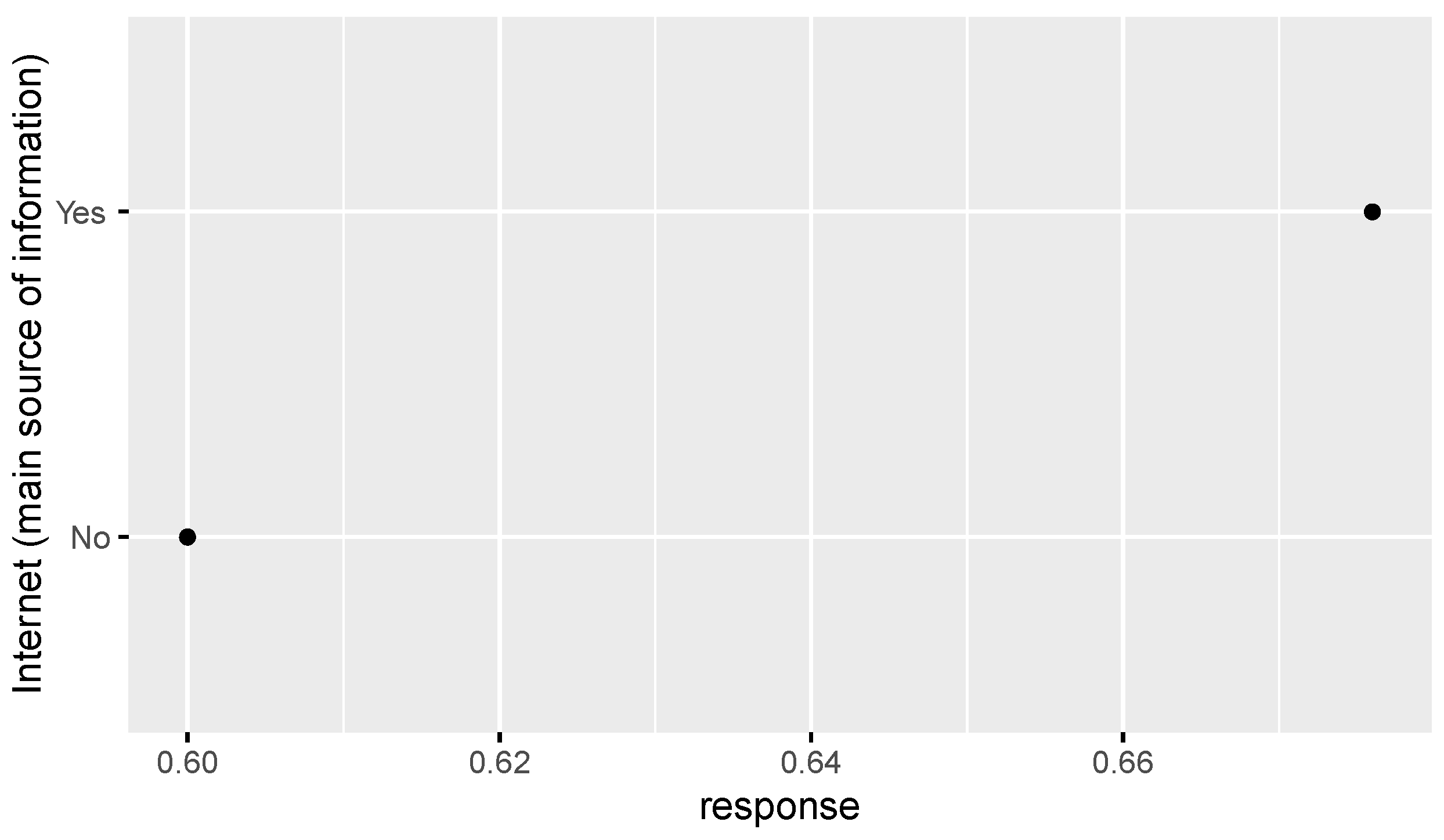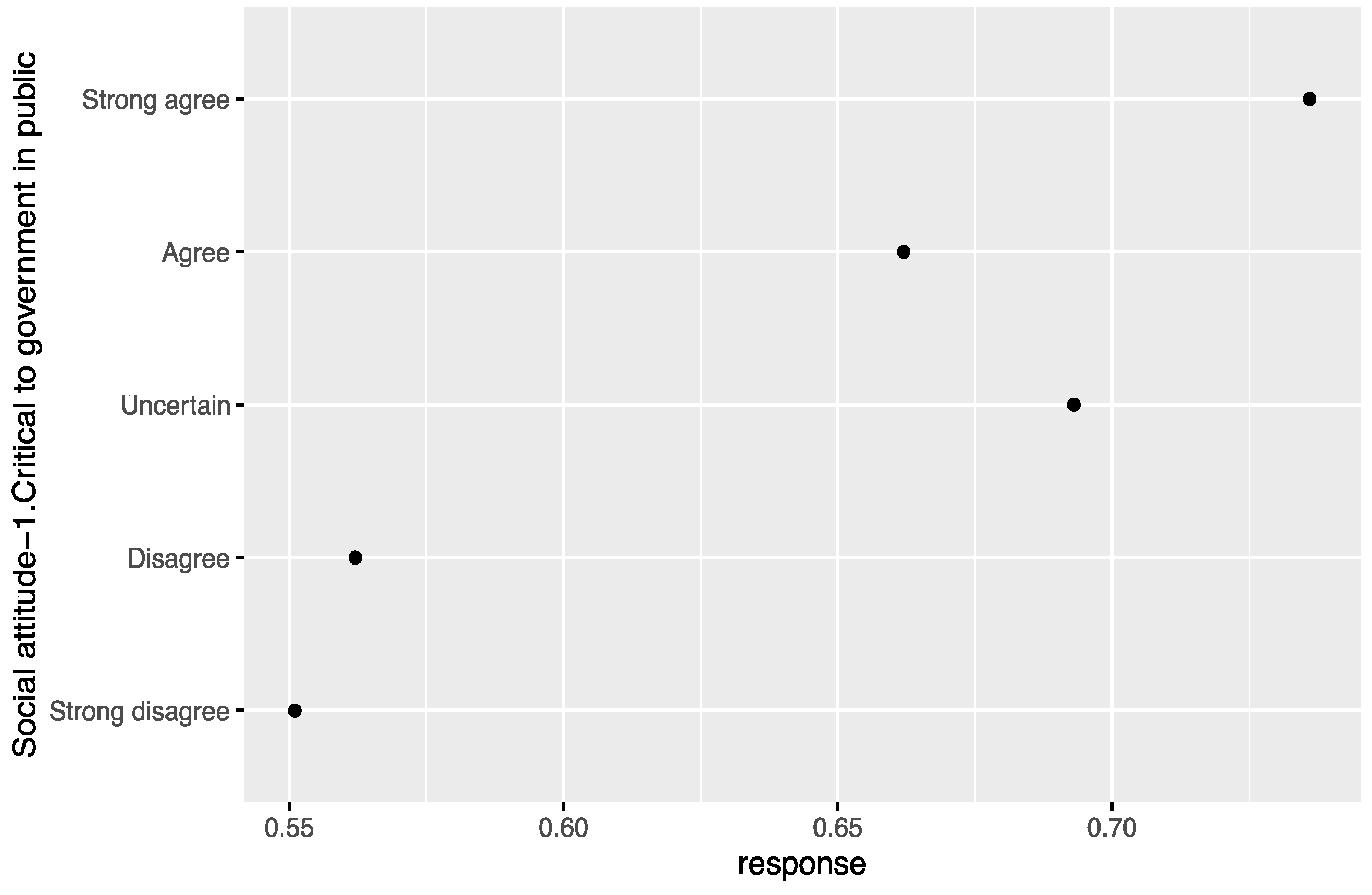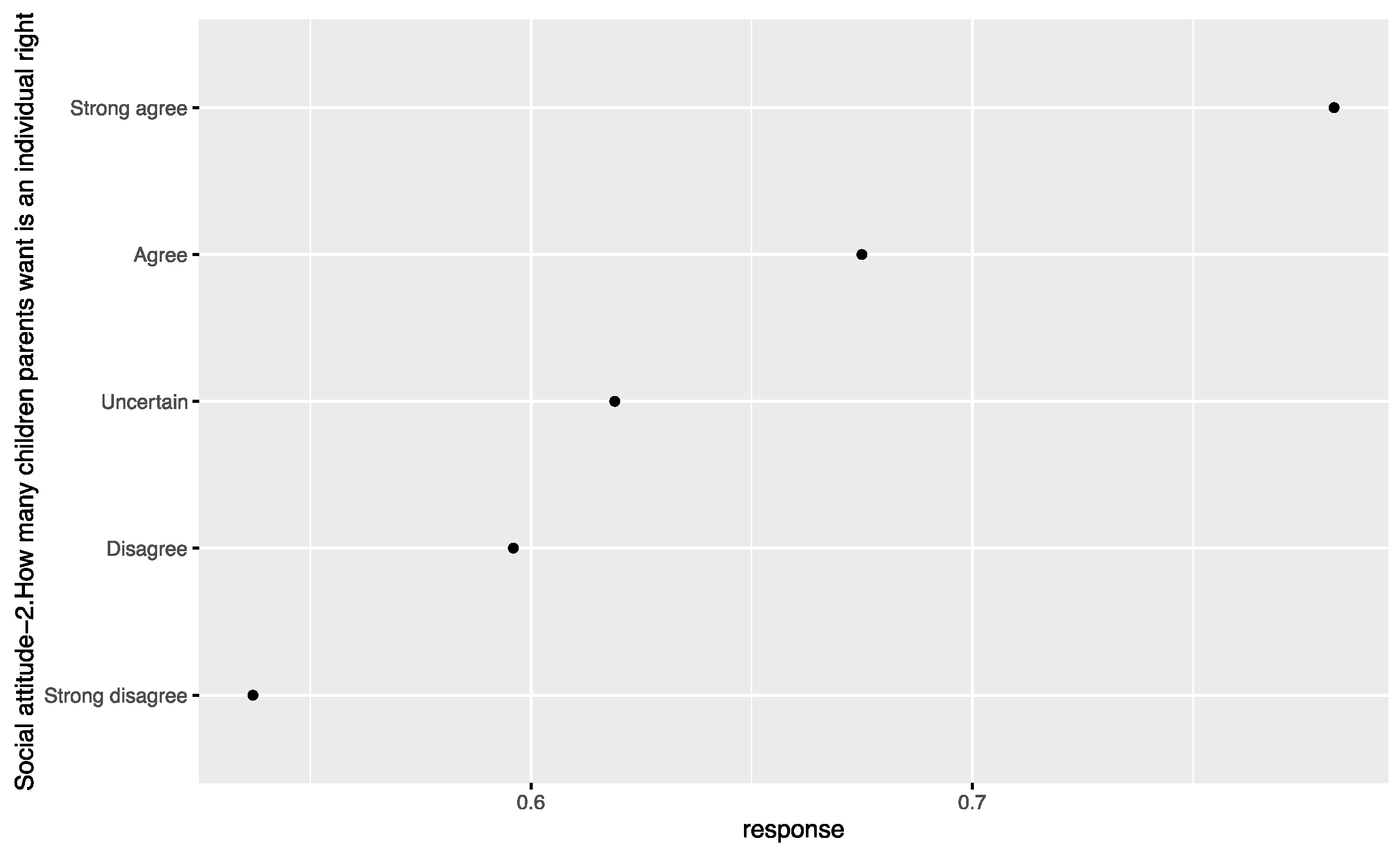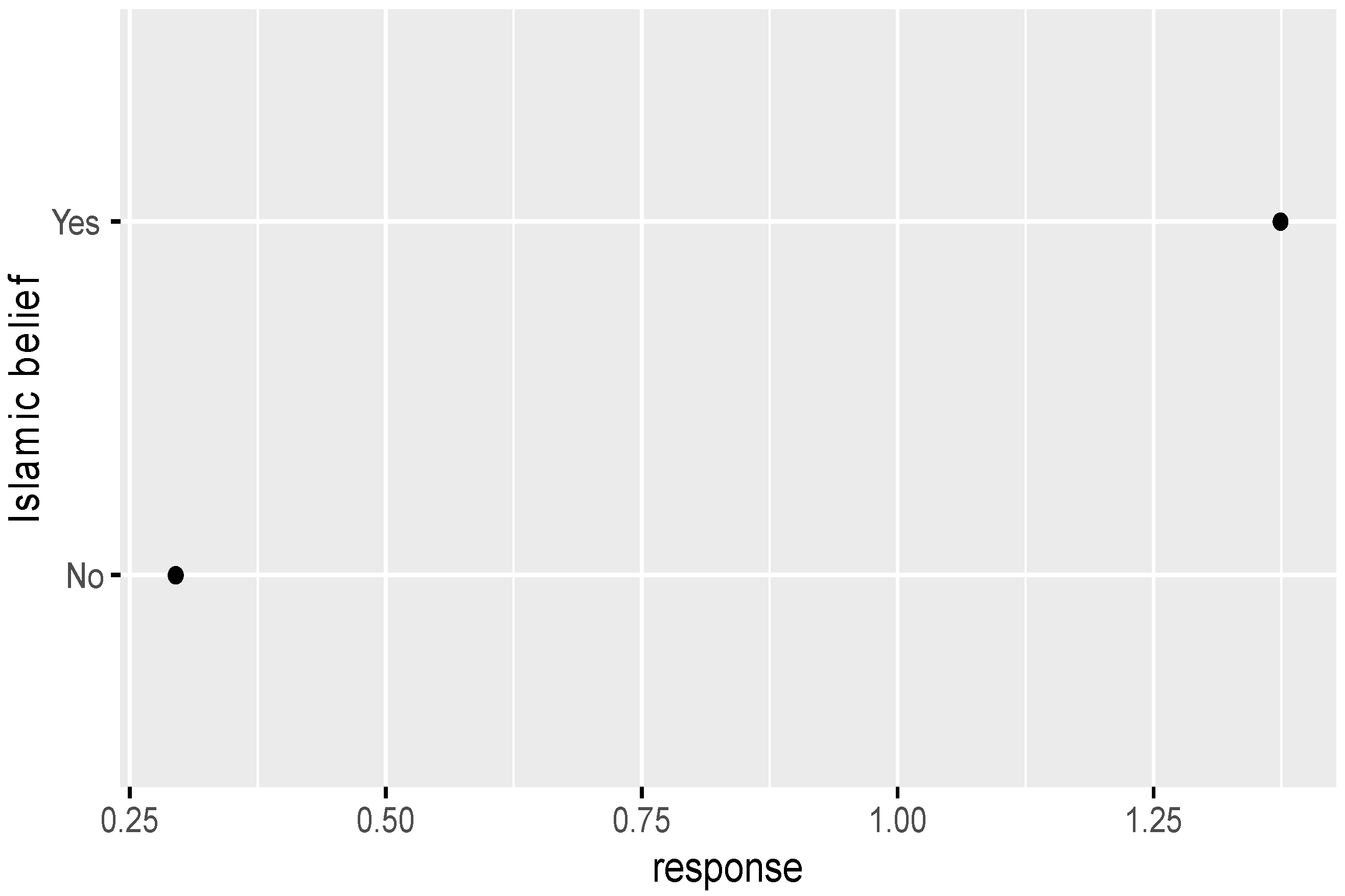Factors Affecting the Public Acceptance of Extramarital Sex in China
Abstract
:1. Introduction
2. Literature Overview and Study Hypotheses
2.1. Literature Overview
2.2. Study Hypotheses
3. Data, Variables and Model
3.1. Data Source
3.2. Variables
3.2.1. Dependent Variables
3.2.2. Independent Variables
- Age group (A3) (See Appendix A. Note nr. 3): According to the respondents’ answers, their ages were recoded into different age groups according to their date of birth: born in the 1990s, 1980s, 1970s, 1960s, 1950s, and 1940s and before.
- The highest level of education (A7a): According to the answers, the answers were recoded as primary school and below, junior high school, senior high school (technical secondary school/technical school), junior college education, undergraduate education, and postgraduate education and above.
- Gender (A2): Dichotomous variable: male and female.
- Income (A62): Family income after taking the logarithm.
- Religious belief (A5): This paper selected four dichotomous variables, namely, Buddhist, Taoist, Muslim. and Christian beliefs, and coded Catholic, Christian, Orthodox, and other Christian beliefs into a dichotomous variable. In response to the question “do you believe in Christianity?”, 1 means yes, and 0 means no.
- Whether the Internet is the main source of information (A29): According to the respondents’ answers, the answers were recoded into one dichotomous variable: the Internet is the main source of information, and media other than the Internet (television, newspapers, etc.) are the main source of information.
- Social attitude variable: 1. (A46) If someone criticizes the government in a public place, the government should not interfere. 2. (A47) The number of children you want to have is a personal matter, and the government should not interfere. Do you agree? The options are 1. strongly disagree, 2. disagree, 3. uncertain, 4. agree, and 5. strongly agree.
3.2.3. Study Model
4. Data Analysis
4.1. Descriptive Statistical Results of Independent Variables
4.2. Results of Regression Analysis
5. Conclusions and Discussion
5.1. Conclusions
5.2. Discussion
Author Contributions
Funding
Institutional Review Board Statement
Informed Consent Statement
Data Availability Statement
Acknowledgments
Conflicts of Interest
Appendix A. Notes
- Through the government’s purchase of social services, these centers will be operated by social service agencies. One comprehensive family service center requires 20 full-time staff members, including at least 14 professional social workers.
- See www.chinagss.org/, (accessed on 1 March 2021)
- The title number here is the number of survey questions in the CGSS questionnaire for easy reference.
- See http://www.pewresearch.org/fact-tank/2015/12/23/americans-are-in-the-middle-of-the-pack-globally-when-it-comes-to-importance-of-religion/, (accessed on 25 February 2021)
| Province | Household Registration | ||
|---|---|---|---|
| Urban Hukou | Rural Hukou | Total | |
| Beijing | 594 | 0 | 594 |
| Tianjin | 432 | 0 | 432 |
| Hebei | 100 | 201 | 301 |
| Shanxi | 200 | 100 | 300 |
| Inner Mongolia | 25 | 75 | 100 |
| Liaoning | 353 | 50 | 403 |
| Jilin | 227 | 278 | 505 |
| Heilongjiang | 325 | 277 | 602 |
| Shanghai | 558 | 0 | 558 |
| Jiangsu | 379 | 125 | 504 |
| Zhejiang | 371 | 123 | 494 |
| Anhui | 151 | 251 | 402 |
| Fujian | 200 | 100 | 300 |
| Jiangxi | 301 | 200 | 501 |
| Shandong | 325 | 275 | 600 |
| Henan | 225 | 375 | 600 |
| Hubei | 350 | 252 | 602 |
| Hunan | 275 | 225 | 500 |
| Guangdong | 378 | 0 | 378 |
| Guangxi | 201 | 200 | 401 |
References
- Allen, E.S.; Atkins, D.C. The Association of Divorce and Extramarital Sex in a Representative US Sample. J. Fam. Issues 2012, 33, 1477–1493. [Google Scholar] [CrossRef]
- Flores, A.R. Examining Variation in Surveying Attitudes on Same-Sex Marriage: A Meta-Analysis. Public Opin. Q. 2015, 79, 580–593. [Google Scholar] [CrossRef]
- Hicks, G.R.; Lee, T.-T. Public Attitudes toward Gays and Lesbians: Trends and Predictors. J. Homosex. 2006, 51, 57–77. [Google Scholar] [CrossRef] [PubMed]
- Twenge, J.M.; Sherman, R.A.; Wells, B.E. Changes in American Adults’ Sexual Behavior and Attitudes, 1972–2012. Arch. Sex. Behav. 2015, 44, 2273–2285. [Google Scholar] [CrossRef]
- Baunach, D.M. Changing Same-Sex Marriage Attitudes in America from 1988 through 2010. Public Opin. Q. 2012, 76, 364–378. [Google Scholar] [CrossRef]
- Hayes, B.C.; Dowds, L. Religion and attitudes towards gay rights in Northern Ireland: The god gap revisited. In The Changing World Religion Map; Springer: Berlin/Heidelberg, Germany, 2015; pp. 3321–3340. [Google Scholar]
- Whitehead, A.L. Politics, Religion, Attribution Theory, and Attitudes toward Same-sex Unions. Soc. Sci. Q. 2014, 95, 701–718. [Google Scholar] [CrossRef] [Green Version]
- Chen, X.-S.; Gong, X.-D.; Liang, G.-J.; Zhang, G.-C. Epidemiologic Trends of Sexually Transmitted Diseases in China. Sex. Transm. Dis. 2000, 27, 138–142. [Google Scholar] [CrossRef] [Green Version]
- Fan, C.S.; Lui, H.-K. Extramarital Affairs, Marital Satisfaction, and Divorce: Evidence from Hong Kong. Contemp. Econ. Policy 2004, 22, 442–452. [Google Scholar] [CrossRef] [Green Version]
- Beijing First Intermediate People’s Court Releases White Paper on Family Trial Governance. Available online: www.sohu.com/a/388082545_260616 (accessed on 2 March 2021).
- Allen, E.S.; Atkins, D.C.; Baucom, D.H.; Snyder, D.K.; Gordon, K.C.; Glass, S.P. Intrapersonal, Interpersonal, and Contextual Factors in Engaging in and Responding to Extramarital Involvement. Clin. Psychol. Sci. Pract. 2005, 12, 101–130. [Google Scholar] [CrossRef]
- DeMaris, A. Burning the Candle at Both Ends: Extramarital Sex as a Precursor of Marital Disruption. J. Fam. Issues 2013, 34, 1474–1499. [Google Scholar] [CrossRef] [Green Version]
- Park, S.H.; Lim, D.O. Preterm Birth and Low Birth Weight in Extramarital Birth in Korea: 2015–2018 Years. J. Health Inform. Stat. 2021, 46, 82–87. [Google Scholar] [CrossRef]
- Vaccarella, S.; Franceschi, S.; Herrero, R.; Munoz, N.; Snijders, P.J.; Clifford, G.M.; Smith, J.S.; Lazcano-Ponce, E.; Sukvirach, S.; Shin, H.-R. Sexual Behavior, Condom Use, and Human Papillomavirus: Pooled Analysis of the IARC Human Papillomavirus Prevalence Surveys. Cancer Epidemiol. Prev. Biomark. 2006, 15, 326–333. [Google Scholar] [CrossRef] [Green Version]
- Michael, R.T.; Wadsworth, J.; Feinleib, J.; Johnson, A.M.; Laumann, E.O.; Wellings, K. Private Sexual Behavior, Public Opinion, and Public Health Policy Related to Sexually Transmitted Diseases: A US-British Comparison. Am. J. Public Health 1998, 88, 749–754. [Google Scholar] [CrossRef] [PubMed] [Green Version]
- Nguyen, N.T.; Subasinghe, A.K.; Wark, J.D.; Reavley, N.; Garland, S.M. Psychological Distress and Risky Sexual Behaviours among Women Aged 16-25 Years in Victoria, Australia. Aust. Fam. Physician 2017, 46, 935–941. [Google Scholar] [PubMed]
- Djamba, Y.K.; Kimuna, S.R. Racial and Gender Differences in Extramarital Sex in the United States in the Last Three Decades. Current Res. J. Soc. Sci. Hum. 2020, 3, 6–18. [Google Scholar] [CrossRef]
- Thornton, A.; Young-DeMarco, L. Four Decades of Trends in Attitudes toward Family Issues in the United States: The 1960s through the 1990s. J. Marriage Fam. 2001, 63, 1009–1037. [Google Scholar] [CrossRef]
- Twenge, J.M.; Carter, N.T.; Campbell, W.K. Time Period, Generational, and Age Differences in Tolerance for Controversial Beliefs and Lifestyles in the United States, 1972–2012. Soc. Forces 2015, 94, 379–399. [Google Scholar] [CrossRef] [Green Version]
- Thompson, A.P. Extramarital Sex: A Review of the Research Literature. J. Sex Res. 1983, 19, 1–22. [Google Scholar] [CrossRef]
- Adamczyk, A.; Pitt, C. Shaping Attitudes about Homosexuality: The Role of Religion and Cultural Context. Soc. Sci. Res. 2009, 38, 338–351. [Google Scholar] [CrossRef]
- Dunbar, J.; Brown, M.; Amoroso, D.M. Some Correlates of Attitudes toward Homosexuality. J. Soc. Psychol. 1973, 89, 271–279. [Google Scholar] [CrossRef]
- Jensen, L.; Gambles, D.; Olsen, J. Attitudes toward Homosexuality: A Cross Cultural Analysis of Predictors. Int. J. Soc. Psychiatry 1988, 34, 47–57. [Google Scholar] [CrossRef]
- Burdette, A.M.; Ellison, C.G.; Sherkat, D.E.; Gore, K.A. Are There Religious Variations in Marital Infidelity? J. Fam. Issues 2007, 28, 1553–1581. [Google Scholar] [CrossRef] [Green Version]
- Steffens, M.C.; Wagner, C. Attitudes toward Lesbians, Gay Men, Bisexual Women, and Bisexual Men in Germany. J. Sex Res. 2004, 41, 137–149. [Google Scholar] [CrossRef]
- Ohlander, J.; Batalova, J.; Treas, J. Explaining Educational Influences on Attitudes toward Homosexual Relations. Soc. Sci. Res. 2005, 34, 781–799. [Google Scholar] [CrossRef]
- Lawson, A.; Samson, C. Age, Gender and Adultery. Br. J. Sociol. 1988, 39, 409–440. [Google Scholar] [CrossRef]
- Treas, J.; Giesen, D. Sexual Infidelity among Married and Cohabiting Americans. J. Marriage Fam. 2000, 62, 48–60. [Google Scholar] [CrossRef]
- Atkins, D.C.; Baucom, D.H.; Jacobson, N.S. Understanding Infidelity: Correlates in a National Random Sample. J. Fam. Psychol. 2001, 15, 735. [Google Scholar] [CrossRef]
- Hu, J.; Lei, S.; Wei, D. Extramarital Sexual Behavior of Floating Minority Population and Social Cultural Relationship. Chin. Public Health 2014, 30, 435–438. [Google Scholar]
- Chen, Q.; Li, H.; Xie, J.; Xiao, N. Research on non-marriage sexually behaviors among truck drivers. Henan J. Prev. Med. 2008, 89–90. [Google Scholar] [CrossRef]
- Hu, Y. Sex Ideologies in China: Examining Interprovince Differences. J. Sex Res. 2016, 53, 1118–1130. [Google Scholar] [CrossRef] [PubMed] [Green Version]
- Glenn, N.D.; Weaver, C.N. Attitudes toward Premarital, Extramarital, and Homosexual Relations in the US in the 1970s. J. Sex Res. 1979, 15, 108–118. [Google Scholar] [CrossRef]
- Patrick, K.; Heywood, W.; Simpson, J.M.; Pitts, M.K.; Richters, J.; Shelley, J.M.; Smith, A.M. Demographic Predictors of Consistency and Change in Heterosexuals’ Attitudes toward Homosexual Behavior over a Two-Year Period. J. Sex Res. 2013, 50, 611–619. [Google Scholar] [CrossRef]
- Jäckle, S.; Wenzelburger, G. Religion, Religiosity, and the Attitudes toward Homosexuality—A Multilevel Analysis of 79 Countries. J. Homosex. 2015, 62, 207–241. [Google Scholar] [CrossRef] [PubMed]
- Roggemans, L.; Spruyt, B.; Droogenbroeck, F.V.; Keppens, G. Religion and Negative Attitudes towards Homosexuals: An Analysis of Urban Young People and Their Attitudes towards Homosexuality. Young 2015, 23, 254–276. [Google Scholar] [CrossRef]
- Robinson, J.P.; Martin, S.P. Social Attitude Differences between Internet Users and Non-Users: Evidence from the General Social Survey. Inf. Commun. Soc. 2009, 12, 508–524. [Google Scholar] [CrossRef]
- Lin, K.; Button, D.M.; Su, M.; Chen, S. Chinese College Students’ Attitudes toward Homosexuality: Exploring the Effects of Traditional Culture and Modernizing Factors. Sex. Res. Soc. Policy 2016, 13, 158–172. [Google Scholar] [CrossRef]
- Kuntz, A.; Davidov, E.; Schwartz, S.H.; Schmidt, P. Human Values, Legal Regulation, and Approval of Homosexuality in Europe: A Cross-country Comparison. Eur. J. Soc. Psychol. 2015, 45, 120–134. [Google Scholar] [CrossRef] [Green Version]
- Wang, C. The Application of the Zero Inflation Model in the Empirical Research of Social Science—Taking the Analysis of the Influencing Factors of Chinese Abortion. Sociol. Res. 2010, 130–148. Available online: http://www.cnki.com.cn/Article/CJFDTotal-SHXJ201005007.htm (accessed on 2 March 2021). (In Chinese).
- Xu, X.; Yuan, W.; Meng, S. Extension of Zero Inflation Negative Binomial Regression Model and Rate Determination. Syst. Eng. Theory Pract. 2012, 32, 127–133. [Google Scholar]
- Lambert, D. Zero-Inflated Poisson Regression, with an Application to Defects in Manufacturing. Technometrics 1992, 34, 1–14. [Google Scholar] [CrossRef]
- Glass, S.P.; Wright, T.L. Sex Differences in Type of Extramarital Involvement and Marital Dissatisfaction. Sex Roles 1985, 12, 1101–1120. [Google Scholar] [CrossRef]
- Cunningham, M.R.; Roberts, A.R.; Barbee, A.P.; Druen, P.B.; Wu, C.-H. Their Ideas of Beauty Are, on the Whole, the Same as Ours: Consistency and Variability in the Cross-Cultural Perception of Female Physical Attractiveness. J. Personal. Soc. Psychol. 1995, 68, 261. [Google Scholar] [CrossRef]
- Rohrbaugh, J.; Jessor, R. Religiosity in Youth: A Personal Control against Deviant Behavior? J. Personal. 1975, 43, 136–155. [Google Scholar] [CrossRef] [PubMed]
- Atkins, D.C.; Kessel, D.E. Religiousness and Infidelity: Attendance, but Not Faith and Prayer, Predict Marital Fidelity. J. Marriage Fam. 2008, 70, 407–418. [Google Scholar] [CrossRef]
- Yunfeng, L. Report on Contemporary Chinese Religious Based on Data of CFPS (2012). World Relig. Cult. 2014, 11–25. [Google Scholar] [CrossRef]






| Attitude toward Extramarital Sex | Freq. a | Percent | Cum. b |
|---|---|---|---|
| Always wrong | 8799 | 78.53 | 78.53 |
| Wrong in most cases | 711 | 6.35 | 84.88 |
| Hard to say whether it is right or wrong | 1433 | 12.79 | 97.67 |
| Sometimes right | 195 | 1.74 | 99.41 |
| Completely right | 66 | 0.59 | 100.00 |
| Total | 11,204 | 100.00 |
| Variable | Freq | % |
|---|---|---|
| Gender | ||
| Male | 5756 | 50.3 |
| Female | 5682 | 49.7 |
| Date of birth | ||
| Born in the 1940s and before | 2269 | 19.8 |
| Born in the 1950s | 2223 | 19.4 |
| Born in the 1960s | 2300 | 20.1 |
| Born in the 1970s | 2252 | 19.7 |
| Born in the 1980s | 1700 | 14.9 |
| Born in the 1990s | 693 | 6.1 |
| The highest level of education | ||
| No education | 1484 | 13.0 |
| Primary school education | 2582 | 22.6 |
| Junior high school education | 3326 | 29.1 |
| Senior high school/technical secondary school education | 2180 | 19.1 |
| Junior college education | 927 | 8.1 |
| Undergraduate education | 843 | 7.4 |
| Postgraduate education and above | 90 | 0.8 |
| Your religious belief—Buddhism | ||
| No | 10,849 | 94.9 |
| Yes | 584 | 5.1 |
| Your religious belief—Islam | ||
| No | 11,192 | 97.9 |
| Yes | 241 | 2.1 |
| Your religious belief—Christianity | ||
| No | 11,204 | 98.0 |
| Yes | 234 | 2.0 |
| If someone criticizes the government in a public place, the government should not interfere | ||
| Strongly disagree | 1004 | 8.9 |
| Disagree | 3915 | 34.6 |
| Uncertain | 3012 | 26.6 |
| Agree | 2737 | 24.2 |
| Strongly agree | 646 | 5.7 |
| The number of children you want to have is a personal matter, and the government should not interfere | ||
| Strongly disagree | 1990 | 17.5 |
| Disagree | 4984 | 43.7 |
| Uncertain | 1782 | 15.6 |
| Agree | 2206 | 19.4 |
| Strongly agree | 436 | 3.8 |
| Whether the Internet is the main source of information | ||
| The Internet is not the main source of information | 8884 | 80.0 |
| The Internet is the main source of information | 2224 | 20.0 |
| Independent Variable a | Dependent Variable: Do You Think Extramarital Sex Is Right? | |||||
|---|---|---|---|---|---|---|
| Model 1 | Model 2 | Model 3 | Model 4 | Model 5 | ||
| Gender (reference group: male) | ||||||
| Female | Regression coefficient b | −0.00246 | −0.00964 | −0.0120 | −0.0274 | −0.0289 |
| Standard deviation | (0.0391) | (0.0395) | (0.0395) | (0.0396) | (0.0400) | |
| Incidence ratio eb | 0.998 | 0.990 | 0.988 | 0.973 | 0.971 | |
| Age (reference group: born in the 1940s and before) | ||||||
| Born in the 1950s | 0.244 ** | 0.226 ** | 0.235 ** | 0.228 ** | 0.250 ** | |
| (0.0805) | (0.0817) | (0.0815) | (0.0814) | (0.0831) | ||
| 1.277 | 1.254 | 1.265 | 1.256 | 1.284 | ||
| Born in the 1960s | 0.281 *** | 0.248 ** | 0.262 ** | 0.235 ** | 0.262 ** | |
| (0.0794) | (0.0826) | (0.0824) | (0.0823) | (0.0838) | ||
| 1.325 | 1.282 | 1.300 | 1.265 | 1.299 | ||
| Born in the 1970s | 0.399 *** | 0.353 *** | 0.363 *** | 0.338 *** | 0.347 *** | |
| (0.0761) | (0.0808) | (0.0806) | (0.0808) | (0.0830) | ||
| 1.490 | 1.424 | 1.437 | 1.403 | 1.415 | ||
| Born in the 1980s | 0.610 *** | 0.496 *** | 0.504 *** | 0.490 *** | 0.475 *** | |
| (0.0744) | (0.0818) | (0.0815) | (0.0821) | (0.0861) | ||
| 1.840 | 1.642 | 1.655 | 1.632 | 1.608 | ||
| Born in the 1990s | 0.748 *** | 0.635 *** | 0.651 *** | 0.635 *** | 0.605 *** | |
| (0.0864) | (0.0941) | (0.0939) | (0.0945) | (0.0993) | ||
| 2.113 | 1.888 | 1.917 | 1.887 | 1.832 | ||
| Income | 0.0120 *** | 0.00608 | 0.00608 | 0.00373 | 0.00364 | |
| (0.00349) | (0.00392) | (0.00395) | (0.00401) | (0.00404) | ||
| 1.012 | 1.006 | 1.006 | 1.004 | 1.004 | ||
| Level of education (reference group: no education) | ||||||
| Primary school education | 0.0527 | 0.0479 | 0.0751 | 0.0671 | ||
| (0.0912) | (0.0907) | (0.0903) | (0.0933) | |||
| 1.054 | 1.049 | 1.078 | 1.069 | |||
| Junior high school education | 0.0178 | 0.00946 | 0.0449 | 0.0352 | ||
| (0.0901) | (0.0896) | (0.0898) | (0.0928) | |||
| 1.018 | 1.010 | 1.046 | 1.036 | |||
| Senior high school/technical secondary school education | 0.193 * | 0.181 * | 0.224 * | 0.195 * | ||
| (0.0918) | (0.0913) | (0.0913) | (0.0949) | |||
| 1.213 | 1.198 | 1.251 | 1.216 | |||
| Junior college education | 0.157 | 0.149 | 0.191 | 0.154 | ||
| (0.103) | (0.103) | (0.103) | (0.107) | |||
| 1.170 | 1.160 | 1.210 | 1.166 | |||
| Undergraduate education | 0.320 ** | 0.308 ** | 0.344 *** | 0.288 ** | ||
| (0.0999) | (0.0998) | (0.100) | (0.106) | |||
| 1.377 | 1.360 | 1.410 | 1.333 | |||
| Postgraduate education and above | 0.504 *** | 0.500 *** | 0.483 *** | 0.414 ** | ||
| (0.146) | (0.146) | (0.146) | (0.151) | |||
| 1.656 | 1.649 | 1.621 | 1.513 | |||
| Religious belief | ||||||
| Buddhist belief (reference group: without Buddhist belief) | 0.0910 | 0.114 | 0.101 | |||
| (0.0859) | (0.0865) | (0.0878) | ||||
| 1.095 | 1.121 | 1.107 | ||||
| Islamic belief (reference group: without Islamic belief) | −1.616 *** | −1.544 *** | −1.516 *** | |||
| (0.291) | (0.290) | (0.290) | ||||
| 0.199 | 0.214 | 0.220 | ||||
| Christian belief (reference group: without Christian belief) | −0.0753 | −0.0367 | −0.0482 | |||
| (0.147) | (0.147) | (0.151) | ||||
| 0.927 | 0.964 | 0.953 | ||||
| Public criticism of the government is personal freedom, and the government should not interfere (reference group: strongly disagree) | ||||||
| Disagree | 0.0350 | 0.0199 | ||||
| (0.0960) | (0.0970) | |||||
| 1.036 | 1.020 | |||||
| Uncertain | 0.243 * | 0.226 * | ||||
| (0.0980) | (0.0990) | |||||
| 1.275 | 1.254 | |||||
| Agree | 0.198 * | 0.184 | ||||
| (0.0969) | (0.0978) | |||||
| 1.218 | 1.202 | |||||
| Strongly agree | 0.312 ** | 0.293 ** | ||||
| (0.112) | (0.113) | |||||
| 1.366 | 1.340 | |||||
| The number of children you want to have is personal freedom, and the government should not interfere (reference group: strongly disagree) | ||||||
| Disagree | 0.0966 | 0.118 | ||||
| (0.0662) | (0.0668) | |||||
| 1.101 | 1.125 | |||||
| Uncertain | 0.133 | 0.154 | ||||
| (0.0788) | (0.0795) | |||||
| 1.142 | 1.167 | |||||
| Agree | 0.220 ** | 0.235 ** | ||||
| (0.0721) | (0.0728) | |||||
| 1.246 | 1.265 | |||||
| Strongly agree | 0.375 *** | 0.380 *** | ||||
| (0.0970) | (0.0983) | |||||
| 1.455 | 1.462 | |||||
| Whether the Internet is the main source of information (reference group: other media are the main source of information) | 0.111 * | |||||
| (0.0542) | ||||||
| 1.118 | ||||||
| Observations | 10042 | 10038 | 10034 | 9937 | 9674 | |
| Chi-square | 125.805 *** | 157.260 *** | 196.891 *** | 256.513 *** | 441.777 *** | |
| Nag R-square | 0.016 | 0.020 | 0.025 | 0.034 | 0.058 | |
Publisher’s Note: MDPI stays neutral with regard to jurisdictional claims in published maps and institutional affiliations. |
© 2021 by the authors. Licensee MDPI, Basel, Switzerland. This article is an open access article distributed under the terms and conditions of the Creative Commons Attribution (CC BY) license (https://creativecommons.org/licenses/by/4.0/).
Share and Cite
Liu, N.; Lu, Z.; Xie, Y. Factors Affecting the Public Acceptance of Extramarital Sex in China. Int. J. Environ. Res. Public Health 2021, 18, 5767. https://0-doi-org.brum.beds.ac.uk/10.3390/ijerph18115767
Liu N, Lu Z, Xie Y. Factors Affecting the Public Acceptance of Extramarital Sex in China. International Journal of Environmental Research and Public Health. 2021; 18(11):5767. https://0-doi-org.brum.beds.ac.uk/10.3390/ijerph18115767
Chicago/Turabian StyleLiu, Nian, Zekai Lu, and Ying Xie. 2021. "Factors Affecting the Public Acceptance of Extramarital Sex in China" International Journal of Environmental Research and Public Health 18, no. 11: 5767. https://0-doi-org.brum.beds.ac.uk/10.3390/ijerph18115767






